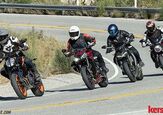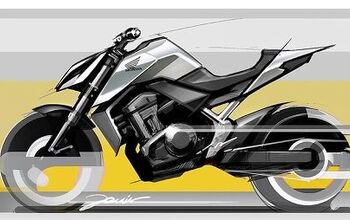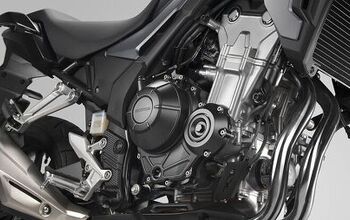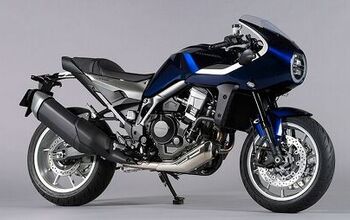Honda Motorcycles
Honda motorcycles’ extensive range covers just about any terrain on earth, at nearly any speed. On the street, they range from the CBR1000RR-R SP World Superbike Racing platform right down to the CB300R “Neo Sports Cafe.” On the dirt, there’s everything from the CRF450R motocrosser and CRF450X endurance racer, right down to the kid-friendly CRF50F. In between them, you’ll find all-terrain dual sports like the Africa Twin, CRF450L and classic XR650L. And at the extremes lie motorcycles like the luxurious Gold Wing Tour, the beginner-friendly Rebel 300 and the all-new `60s throwback Honda Monkey.
Honda produced its first real motorcycle, the Model D, in 1949. Since then it’s gone on to become one of the world’s leading motorcycle manufacturers – and that’s not even mentioning automobiles, ATVs, jet airplanes, etc. More than 50 million Honda Super Cubs have been sold in less than 50 years, making it the most popular motorcycle of all time. From it’s CBR line of sportbikes to its CRF line of off-road machines to the luxurious Gold Wing Touring motorcycle, Honda has a bike for just about everybody. Here are just a few of our favorites.
Gold Wing
Totally overhauled for 2018 with an all-new 1833 cc boxer six that’s more powerful as well as more fuel-efficient, the new `Wing carries on the tradition of the bike that basically invented luxury long-distance motorcycle touring. The optional Dual Clutch Transmission makes the bike amazingly easy to ride. Making the entire bike smaller and lighter while updating the suspension makes it way sportier, and adding modern electronics was a big part of the overhaul: A 7-inch TFT houses the infotainment/navigation system (now approved for use with Apple CarPlay). Together with sister ship Gold Wing Tour – which adds a top box and a few other amenities – this bike has created its own dedicated community, and with good reason. In 2020 Honda announced a few improvements to the Gold Wing, including a revised top box on the Tour model that is 11 liters larger – for a total of 61 liters – making it easily able to swallow up two full-size helmets. Those of you who routinely tour two-up know just how big that improvement is. Pun not intended. Passenger accommodations now also feature a more relaxed backrest angle, thicker seat foam, and a taller profile.
Honda has a long storied history of success in racing. More recently in MotoGP, the Japanese company (with the help of incredible riders) has more often than not, come away with the championship over the past 10 years. The latest and greatest sport motorcycle available from Honda features trickle-down technology from its racing success. The CBR1000RR-R SP is the raciest CBR to date, with minimal considerations for the street and maximum attention to racetrack performance. Substantial upgrades have been made to the engine to bring a more powerful, more efficient, higher-revving inline-Four than the CBR has ever had. Chassis changes have also been made. The frame is now slimmer and offers increased torsional rigidity while second-generation semi-active Öhlins Electronic Control units handle suspension duties up front while the fully adjustable Öhlins TTX36 shock keeps things under control out back. Bosch’s six-axis IMU helps to deliver information to the most technologically advanced electronics package to ever grace the CBR moniker. Click here to read our First Ride Review of the CBR1000RR-R SP.
Introduced in 2016 as an homage to the successful XRV650 and XRV750, this full-scale adventure bike was immediately heralded for being equally capable of crossing rugged continents and highway cruising. For 2018, the “True Adventure” spirit of the original AT expanded with the introduction of the CRF1000L2 Africa Twin Adventure Sports, with a big 6.4-gallon fuel tank among other things, designed to give it even greater range. Both Africa Twins use a powerful, highly tractable 998 cc Parallel-twin to let these bikes make their way through, over or around nearly any obstacle, and both are available with Honda’s excellent DCT transmission. For 2020, Honda listened to its customers and updated the Africa Twin with some major changes, not least of which is the bigger 1,084cc Parallel-Twin engine with 270º firing order. With the bigger engine comes some much needed urgency in everything that it does. The beauty of the revised AT, however, is how well Honda has harnessed it to do basically whatever you want. From a practical daily rider to a weekend dirt warrior, the Africa Twin can do it all. In this digital age, Honda’s ability to harness the Africa Twin’s abilities is thanks to the robust electronics package not seen on the 2016 model. Centered around Bosch’s MM7.10 six-axis IMU, the Africa Twin now comes with all the rider aids you expect to see on top-end sportbikes – all wrapped up in a clever Adventure-Touring package.
It doesn't always have to be serious does it? Riders of a certain age all remember 1968, when the first Z50A was made available in the U.S., complete with 8-inch wheels, knobby tires, adjustable seat, and lovable, cartoon styling. As of 2020, the Monkey is reborn: Chrome steel high-mount fenders with stamped exhaust shield, circular mirrors, and high-rise handlebars pay homage to the original, but the new Monkey is powered by a modern, reliable 125 cc single-cylinder, and is even available with ABS brakes. Maybe you can go home again?
Honda built its reputation in America by producing little, approachable motorcycles that appealed to the masses as cheap, easy transportation. In the process, people came to realize that Hondas were not only reliable and inexpensive, but they were also fun. The modern Super Cub is the reincarnation of the original Super Cub of the late 1950s and early 1960s that brought Honda into the homes of America. This new version borrows heavily from the original’s design, but sports thoroughly modern technology...like disc brakes and fuel injection. Otherwise, the 125cc air-cooled Single is shared among the Monkey, Grom, and Trail 125, but in Super Cub form it’s mated to a semi-automatic transmission to rekindle what made the original so appealing – a very smooth learning curve. That’s what we need to get more people on two wheels, right?



















































